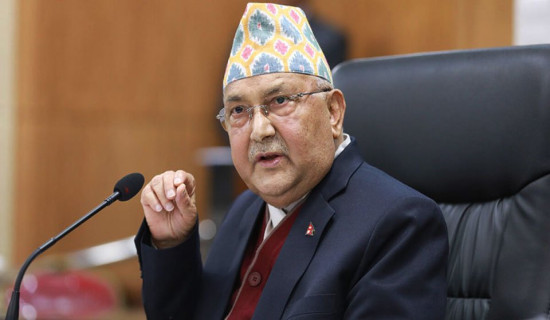- Friday, 18 July 2025
Phewa Lake’s boundary demarcated
By Phadindra Adhikari,Lekhnath, July 18: The high-water mark (flood level) of Phewa Lake, a major attraction in the country’s tourism capital, Pokhara, has now been officially determined. Around 611 physical poles have been installed along a 16-kilometre stretch of the lake's perimeter to mark its boundary.
On May 31, 2025, representatives from all three levels of government jointly began the pole installation. By Wednesday, all the poles had been successfully placed. According to Dhanraj Acharya, Mayor of Pokhara Metropolitan City, poles have been fixed in all technically suitable locations identified by the expert team.
“In about one and a half months, we installed the poles with proper markings, even in slopes and difficult terrain. To implement the Supreme Court’s decision, the work was carried out with the coordination of Pokhara Metropolitan City, Gandaki Province Government, and the Federal Government -- and with active support from the municipal police, Nepal Police, Armed Police Force and the local community,” said Mayor Acharya.
Prakash Subedi, Chief of the Pokhara Valley Town Development Committee, said that although 1,055 points were identified by the technical team, poles were installed only where possible. For areas under water, on ridges, or steep slopes, alternative markers have been used instead.
In the second phase, the authorities will begin classifying land parcels that fall within the lake area and within 65 metres of the lake's official boundary. During this phase, land eligible for compensation and land deemed unsuitable (contaminated land) will be identified.
He said, “In the third phase, we will recommend compensation for those eligible. The land will be vacated only after the landowners receive compensation.”
Previously, the Supreme Court had ordered that land registered by individuals after the Phewa dam broke be considered illegal and vacated. Over 4,500 land parcels are estimated to fall within Phewa Lake’s protected area.
The lake has been heavily encroached upon, both by natural expansion and human activity. Many individuals and organisations have built houses, hotels and commercial buildings within the restricted zone.
In 2018, the Supreme Court issued a mandamus order to the government to maintain a 65-metre protected buffer around the lake, demarcate the boundary and remove all illegal structures built around the lake.
















